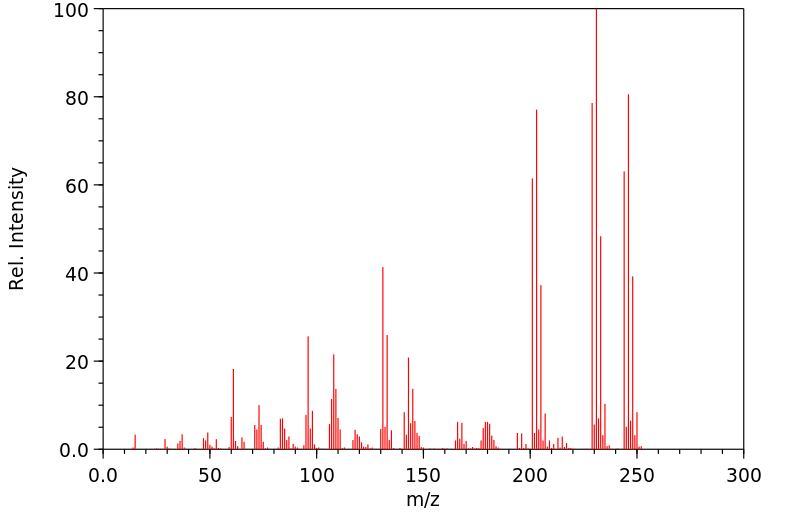2,3,4,6-四氯苯甲醚 | 938-22-7
中文名称
2,3,4,6-四氯苯甲醚
中文别名
1,2,3,5-四氯-4-甲氧基苯
英文名称
2,3,4,6-tetrachloroanisole
英文别名
2,4,5,6-tetrachloroanisole;2,3,4,6-tetrachloro-anisole;2,3,4,6-Tetrachlor-anisol;2.3.4.6-Tetrachlor-1-methoxy-benzol;Methyl-(2.3.4.6-tetrachlor-phenyl)-aether;1,2,3,5-tetrachloro-4-methoxy-benzene;1,2,3,5-tetrachloro-4-methoxybenzene
CAS
938-22-7
化学式
C7H4Cl4O
mdl
——
分子量
245.92
InChiKey
ITXDBGLYYSJNPK-UHFFFAOYSA-N
BEILSTEIN
——
EINECS
——
-
物化性质
-
计算性质
-
ADMET
-
安全信息
-
SDS
-
制备方法与用途
-
上下游信息
-
文献信息
-
表征谱图
-
同类化合物
-
相关功能分类
-
相关结构分类
物化性质
-
溶解度:可溶于氯仿(少许)、甲醇(少许)
-
物理描述:Solid
-
熔点:64-65°C
-
保留指数:1500;1520;1530;1506;1520;1538;1520;1484;1522.6
计算性质
-
辛醇/水分配系数(LogP):4.8
-
重原子数:12
-
可旋转键数:1
-
环数:1.0
-
sp3杂化的碳原子比例:0.14
-
拓扑面积:9.2
-
氢给体数:0
-
氢受体数:1
安全信息
-
海关编码:2909309090
-
包装等级:III
-
危险类别:9
-
危险性防范说明:P264,P270,P273,P280,P301+P312+P330,P302+P352+P312,P305+P351+P338+P310,P332+P313,P391,P501
-
危险品运输编号:3077
-
危险性描述:H302+H312,H315,H318,H411
-
储存条件:存储条件:2-8°C,干燥
SDS
上下游信息
-
上游原料
中文名称 英文名称 CAS号 化学式 分子量 2,3,4,6-四氯酚 2,3,4,6-tetrachlorophenol 58-90-2 C6H2Cl4O 231.893
反应信息
-
作为反应物:描述:参考文献:名称:Kohn; Pfeiffer, Monatshefte fur Chemie, 1927, vol. 48, p. 226摘要:DOI:
-
作为产物:描述:参考文献:名称:Kohn; Pfeiffer, Monatshefte fur Chemie, 1927, vol. 48, p. 226摘要:DOI:
文献信息
-
An adaptive social network for information access: Theoretical and experimental results作者:Bin Yu、Mahadevan Venkatraman、Munindar P. SinghDOI:10.1080/713827056日期:2003.1approaches, our architecture is fully distributed and includes agents who preserve the privacy and autonomy of their users. These agents learn models of each other in terms of expertise (ability to produce correct domain answers) and sociability (ability to produce accurate referrals). We study our framework experimentally to study how the social network evolves. Specifically, we find that under our multi-agent我们考虑了一个软件代理的社交网络,他们互相帮助,帮助用户查找信息。与之前的大多数方法不同,我们的架构是完全分布式的,并且包括保护用户隐私和自主权的代理。这些代理在专业知识(产生正确领域答案的能力)和社交能力(产生准确推荐的能力)方面相互学习模型。我们通过实验研究我们的框架,以研究社交网络如何发展。具体来说,我们发现在我们的多智能体学习启发式下,网络的质量随着交互而提高:当同时考虑专业知识和社交能力时,质量最大化;枢轴代理进一步提高了网络的质量,并对其质量产生催化作用,即使它们最终被移除。而且,
-
Aromas Kit申请人:Bustos Veronica L公开号:US20110003732A1公开(公告)日:2011-01-06An Aromas kit uses containers of certain discrete molecules to provide odors suitable for an olfactory education of wine properties. The disclosed molecules may be found within certain wines and provide a useful olfactory reference when smelling a finished wine sample, even when the wine sample contains a myriad of other conflicting or competing molecule smells.一个香气套装使用特定的离散分子容器,为葡萄酒属性的嗅觉教育提供适当的气味。披露的分子可能存在于某些葡萄酒中,并在闻成品葡萄酒样品时提供有用的嗅觉参考,即使葡萄酒样品中含有众多其他冲突或竞争分子的气味。
-
Chloration additive du fluorobenzène作者:Angelo Germano、Gabriel SéchaudDOI:10.1002/hlca.19540370442日期:——Nous avons isolé des produits de photochloration du fluorobenzène, un fluoro-hexachloro- et un fluoro-heptachloro-cyclohexane. Ce dernier composé, qui s'obtient également par addition de chlore au p-fluoro-chlorobenzène, donne, sous l'action du méthylate de sodium, le fluoro-1-tétrachloro-2,3,4,6-benzène, dont l'atome de fluor est relativement mobile.
-
Process for preparing branched poly(arylene sulfide ketone)申请人:PHILLIPS PETROLEUM COMPANY公开号:EP0450635A2公开(公告)日:1991-10-09A process for preparing a branched, high molecular weight poly(arylene sulfide ketone) by the addition of a polyhaloaromatic compound to a reaction mixture containing a dihaloaromatic ketone, an organic amide, an alkali metal sulfide, and water, and the product produced therefrom.
-
METHOD FOR DETECTING A VOLATILE ANALYTE FOR CLASSING AND SORTING CORK STOPPERS DEPENDING ON THE CONCENTRATION OF THE ANALYTE申请人:Cork Supply Portugal, S.A.公开号:EP3165918A1公开(公告)日:2017-05-10A method for detecting a volatile analyte for categorization and separation of cork stoppers depending on the concentration of the said analyte, with the detection being carried out in concentrations within the range of ng/L (parts per trillion), in a concentrated gas over the cork stoppers, confined to a closed conditioning system. In the said method, the cork stoppers are separately or jointly led to an incubation chamber (1); air or nitrogen is injected into the incubation chamber (1), dragging the gas enriched in the cork's volatile compounds and carrying it to the concentration system which is provided with a trap (4), the latter being meanwhile heated for desorption of the volatile compounds; these are led by the dragging gas towards a detection system (6) which registers a signal related to the presence of the analyte, this signal being used for purposes of classification of the cork stopper or groups of cork stoppers; finally, a software receives the signal and compares it with the established minimum threshold, taking a decision of approval or rejection. An installation for the operation of the said method is also described.一种检测挥发性分析物的方法,用于根据上述分析物的浓度对软木塞进行分类和分离,检测浓度在纳克/升(万亿分之一)范围内,在软木塞上方的浓缩气体中进行,并限制在一个封闭的调节系统中。在上述方法中,软木塞被分别或共同导入一个培养室(1);空气或氮气被注入培养室(1),拖曳富含软木塞挥发性化合物的气体,并将其带入配有捕集器(4)的浓缩系统,同时加热捕集器以解吸挥发性化合物;最后,一个软件接收信号,并将其与设定的最低阈值进行比较,做出批准或拒绝的决定。此外,还介绍了上述方法的操作装置。
表征谱图
-
氢谱1HNMR
-
质谱MS
-
碳谱13CNMR
-
红外IR
-
拉曼Raman
-
峰位数据
-
峰位匹配
-
表征信息
同类化合物
(R)-3-(叔丁基)-4-(2,6-二异丙氧基苯基)-2,3-二氢苯并[d][1,3]氧杂磷杂环戊烯
(2S,3R)-3-(叔丁基)-2-(二叔丁基膦基)-4-甲氧基-2,3-二氢苯并[d][1,3]氧杂磷杂戊环
(2S,2''S,3S,3''S)-3,3''-二叔丁基-4,4''-二甲氧基-2,2'',3,3''-四氢-2,2''-联苯并[d][1,3]氧杂磷杂戊环
(2R,2''R,3R,3''R)-3,3''-二叔丁基-4,4''-二甲氧基-2,2'',3,3''-四氢-2,2''-联苯并[d][1,3]氧杂磷杂戊环
(2-氟-3-异丙氧基苯基)三氟硼酸钾
(+)-6,6'-{[(1R,3R)-1,3-二甲基-1,3基]双(氧)}双[4,8-双(叔丁基)-2,10-二甲氧基-丙二醇
麦角甾烷-6-酮,2,3,22,23-四羟基-,(2a,3a,5a,22S,23S)-
鲁前列醇
顺式6-(对甲氧基苯基)-5-己烯酸
顺式-铂戊脒碘化物
顺式-四氢-2-苯氧基-N,N,N-三甲基-2H-吡喃-3-铵碘化物
顺式-4-甲氧基苯基1-丙烯基醚
顺式-2,4,5-三甲氧基-1-丙烯基苯
顺式-1,3-二甲基-4-苯基-2-氮杂环丁酮
非那西丁杂质7
非那西丁杂质3
非那西丁杂质22
非那西丁杂质18
非那卡因
非布司他杂质37
非布司他杂质30
非布丙醇
雷诺嗪
阿达洛尔
阿达洛尔
阿莫噁酮
阿莫兰特
阿维西利
阿索卡诺
阿米维林
阿立酮
阿曲汀中间体3
阿普洛尔
阿普斯特杂质67
阿普斯特中间体
阿普斯特中间体
阿托西汀EP杂质A
阿托莫西汀杂质24
阿托莫西汀杂质10
阿托莫西汀EP杂质C
阿尼扎芬
阿利克仑中间体3
间苯胺氢氟乙酰氯
间苯二酚二缩水甘油醚
间苯二酚二异丙醇醚
间苯二酚二(2-羟乙基)醚
间苄氧基苯乙醇
间甲苯氧基乙酸肼
间甲苯氧基乙腈
间甲苯异氰酸酯







